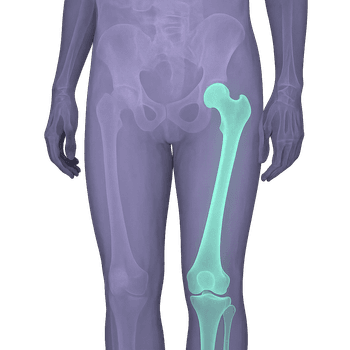Quick version
The femur is the body's most important bone for walking and strength and is often involved in hip and knee-related problems.
- Is the body's longest and strongest bone
- Connects the hip to the knee
- Plays a crucial role in walking, running and balance
- Common problems include fractures and osteoarthritis
- Diagnosis is done via clinical examination and imaging techniques
What is the femur?
The femur is the large bone that extends between the hip joint and the knee joint. The femur plays a crucial role in the body's movement and stability, bearing a large part of the body's weight and serving as an attachment point for several powerful muscles. Its design makes it possible to walk, run and jump.
Anatomy and structure
The femur consists of a round head that fits into the hip joint's glenoid, which is a long cylindrical body (diaphysis), and a lower part that forms the knee joint together with the tibia. The bone is surrounded by muscles and has a rich blood supply.
Function and biomechanics
The femur functions as a force-transmitting bone in walking, running and jumping. It rotates and bends at both the hip and knee, making it important for the body's movement patterns, balance and load distribution.
The femur in hip and knee function
In the hip joint, the femoral head functions as a ball and socket joint, allowing for great mobility in several directions. In the knee joint, the condyles of the femur form a hinge movement together with the tibia and patella.
Common conditions and diseases
Pain in the femur can be due to fracture, stress fracture, muscle rupture, osteoarthritis of the hip or knee, or bone marrow diseases. Hip fractures are common in older people with osteoporosis.
Examination and diagnosis
Diagnosis is made using a physical examination, gait analysis and imaging tests such as X-rays, MRI of the femur or computed tomography. It is important to evaluate whether the pain is coming from the bone, muscles, or joint.
Relevant symptoms
- Deep pain in the thigh or hip
- Difficulty supporting the leg
- A limp or difficulty walking
- Sudden pain after a fall or trauma
- Pain with weight bearing or at rest
Related conditions and diagnoses
- Fracture of the femur
- Hip osteoarthritis
- Femoroacetabular impingement (FAI)
- Stress fracture of the femur
- Fractures related to osteoporosis
























